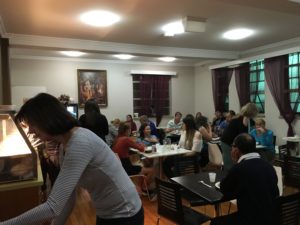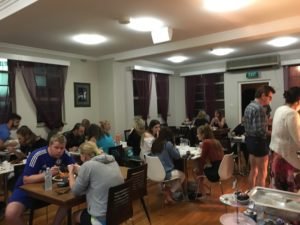Are women less intelligent than men?
Men and women are not identical. The differences between them are the basis by which they legitimately tend to play different roles and have different responsibilities in the world.
First, we can speak in generalities about these differences from the perspective of what modern studies have shown, particularly as it pertains to the topic at hand, intelligence. Then we can consider how Vedic statements treat the subject. Finally we can ask how this pertains to statements from the founder of ISKCON, Srila Prabhupada.
Current View
Current psychology recognizes that intelligence is multifaceted. Women excel at some facets of intelligence and men excel at others. Men deviate from the average IQ more widely than women, thus the rare cases of extreme stupidity and genius are found more often among males.
The male nature is more goal-oriented, thus they make decisions with more finality and confidence. They also have far greater musculature. These two factors (not intellect) account for why males have almost always been dominant gender in political and military leadership capacities.
Women are more emotional, but it does not indicate that they are irrational. They simply have more perceptive acuity than men, which extends into the emotional realm. Their intellect is less goal-driven, more contemplative and sometimes more intuitive.
Vedic Opinion
Vedic Śāstra does not support the conclusion that women are less intelligent than men. A definitive statement that women are less intelligent than men would be strongest if it occurred in context: in a section of śāstra comparing women and men. At the very least, it should have a clear, direct statement that “women are less intelligent than men.”
Let us look at a few contentious quotes from the pinnacles of Vedic Literature, Mahābhārata’s Bhagavad Gītā and the Brahma-sūtra’s elaboration, Śrīmad Bhāgavatam, and evaluate whether such quotes meet the above criteria.
Kunti, “We Women” – ŚB 1.8.20
One statement from Queen Kuntī is sometimes cited as evidence that Vedic culture considers women less intelligent than men. This statement, however, does not appear in a section concerned with a comparison between men and women, nor does it even have a direct statement regarding intelligence. Therefore it must be dismissed.
The statement is the third verse in her very poetic outpouring of petition to Krishna. In the first verse she said, “You are beyond perception.” (alakṣya) The second continues, saying, “A curtain of delusion covers our eyes, making them incapable of perceiving you, Adhokṣaja.”
The verse in question then says,
tathā paramahaṁsānāṁ munīnām amalātmanām
bhakti-yoga-vidhānārthaṁ kathaṁ paśyema hi striyaḥ
“Thus (tathā) only the greatest swans amongst scholars (paramahaṁsānāṁ munīnām) who are not covered by that curtain of delusion (amalātmanā) can see you through the conduit of devotion (bhakti-yoga-vidhānārtha). How surprising that we ladies see you now! (kathaṁ paśyema hi striyaḥ)”
It is unfounded to consider this a comparison between men and women. It is a comparison between paramahaṁsa and regular people.
One may ask, “Is it a comparison between paramahaṁsa and women?”
Yes, but this does not imply that women cannot also be paramahaṁsa. Such a conclusion would contradict the well-established siddhānta that anyone can become perfect in bhakti and attain the highest spiritual realizations (paramahaṁsa).
One may ask, “Why does she say striyaḥ (women) and not lokāḥ (ordinary people)?”
Quite likely because she is a woman.
One may ask, “Why does she say striyaḥ (plural) and not strīḥ (singular)?”
There are three complimentary reasons:
(A) In Sanskrit “we” is often used for “I.”
(B) Similarly, people often talks from the perspective of being the member of a group.
(C) She was speaking to Krishna via addressing the women who surrounded her. [1.8.45 indicates that she was standing with other women.]
Śrīla Viśvanātha’s comment indicates that she is speaking on the basis of being a member of a group.
One may say, “The point of her identification with women as a group is because women are less intelligent. That is why she expresses surprise that she can see Krishna.”
Nothing in the verse or anything surrounding it suggests that Kuntī is talking about comparing her intelligence with the intelligence of paramahaṁsa munīs. Kuntī devī identifies the outstanding trait of paramahaṁsa munī (distinguishing him or her from the more common munī) as their devotion (bhakti) not their intellect. She has said so explicitly, by describing the paramahaṁsa munī as bhakti-yoga-vidhānārtha.
Sūta, “Fools” – ŚB 1.4.25
A statement made by Śrī Sūta is sometimes cited as evidence that Vedic culture considers women less intelligent than men.
strī-śūdra-dvijabandhūnāṁ trayī na śruti-gocarā
karma-śreyasi mūḍhānāṁ śreya evaṁ bhaved iha
iti bhāratam ākhyānaṁ kṛpayā muninā kṛtam
“Women, Laborers, and the so-called educated classes cannot grasp the three Vedas. These fools therefore certainly could not comprehend what was in their best interest, what they should strive for. This is why the Muni [Vyāsa] compiled the Tale of Bhārata [Mahābhārata].”
Again the context here is not to compare men and women, it is to explain why Vyāsa compiled the Mahābhārata and, subsequently, the Bhāgavatam.
The verse does call some people “fools” (mūḍha), indicating that someone is “less intelligent” than someone else. But it does not say that women are less intelligent than men. Specifically it says that women (strī), laborers (śūdra) and the so-called educated classes (dvija-bandhu) are fools.
Thus the verse does not support the claim that women are more foolish than men. It supports the idea that women and men are more foolish then they need to be to understand the Veda effectively.
One may ask, “Does this mean that there are some men who are intelligent enough, but never any women?”
A few verses prior to this (17-18), Sūta stated that all people in this age (kali-yuga) are bereft of potency and are dvija (“educated”) in name only (dvija- bandhu). The phrase kalau śūdra sambhavāḥ confirms this. Thus the verse actually means that everyone in kali-yuga is unintelligent.
One may ask, “Why are women mentioned distinctly?”
Strī literally means expanders, procreators. It indicates women in the role of mothers. Other words can indicate women in other ways, nārīnām, for example. These statements group people according to their primary duties. Mothers have certain duties, so they are listed as a group when mentioning the other groups of duties, such as laborers, farmers, governors, and priests.
One may ask, “Does this indicate that women are not educated in Vedic culture?”
No. Women who were educated formally performed the various duties for which they were educated. For more information, please examine the resources cited on this article.
Krishna, “Lower Birth” – Gītā 9.32
Some cite a statement of Krishna in Gītā as evidence that Vedic culture held women to be of lower birth, and therefore inferior to and less intelligent than men.
māṁ hi pārtha vyapāśritya ye ’pi syuḥ pāpa-yonayaḥ
striyo vaiśyās tathā śūdrās te ’pi yānti parāṁ gatim
“Pātha, if someone turns to me he can certainly attain the supreme destination, even if he might be from a sinful family, or a woman, or a merchant, or a laborer.”
Again, the context here is not a comparison of women and men, nor is there a direct statement that women are less intelligent than men.
The obvious thrust of the verse is that everyone can attain the supreme spiritual perfection through bhakti-yoga. Even those who are not qualified for other paths of yoga — those with a sinful family background (pāpa-yonaya), those who are mothers/ women (striya), those who are money-minded (vaiśya), and those who are simpletons (śūdra).
One may ask, “Does this statement show that it is sinful to be born as a woman?”
No. It is not a statement that it is sinful to be born as a woman – pāpa-yonaya is a distinct group of people outside the Vedic culture.
We must note that there is no mention of intelligence in this verse.
Krishna, “Among Women I am Intelligence” Gītā 10.34
Though we could not find a clear, direct statement that women are less intelligent than men, we can easily find a very clear and very direct statement that Krishna considers women to epitomize intelligence.
kīrtiḥ śrīr vāk ca nārīṇāṁ smṛtir medhā dhṛtiḥ kṣamā
“Among women I am the goddess Kīriti – the epitome of venerable reputation, Śrī – the epitome of beauty and opulence, Vāk – the epitome of excellent speech, Smṛti – the epitome of memory and contemplation, Medhā – the epitome of intelligence, Dhṛti – the epitome of forbearance, and Kṣamā – the epitome of forgiveness.”
The goddesses Sarasvatī, Vāk, Medhā, and Smṛti epitomize the highest standards of education, verbal excellence, intellect, and contemplation respectively. Krishna associates these qualities not just with the goddesses but with their facsimiles, human females (nārīṇām).
Indeed the important Vedic mantra like Gāyatrī and even the Vedas themselves are personified in female form.
Gopīs and Rādhārānī
It is also quite conspicuous that Gauḍīya Vaiṣṇavas consider females to be the most perfected and accomplished spiritualists. This refers, of course, to the gopīs and their epitome, Śrīmatī Rādhārānī – who have unparalleled expertise in all the 64 departments of education, and who are the supreme vedāntists.
It may be argued that the gopīs are not ordinary women, but they are women nonetheless. It is very difficult to explain why the most educated, expert and qualified spiritual beings would appear in a form even resembling women, if women are truly inferior and less intelligent.
A.C. Bhaktivedānta Swāmī Prabhupāda
Although it seems clear that it is not to be a Vedic conclusion that women are less intelligent, ISKCON’s founder, Śrīla Prabhupāda made many statements describing women as less intelligent. This poses a problem because a bonafide guru must represent the conclusions of śāstra.
The problem can be addressed in five ways.
1) We may decide not to place our faith in Śrīla Prabhupāda and look for a guru who does not present opinions that are not obviously in harmony with the śāstra.
2) We may identify his statements on female intelligence and inferiority as a semantic misunderstanding, and try to adjust the meaning of his words so that they do not contradict the Vedic conclusions.
3) We may accommodate that it is acceptable to see the guru as someone who speaks with authority on certain areas of expertise, but not as an absolute authority on all conceivable areas. We could then trace Prabhupāda’s statements about women to semi-Vedic sources like the misogynist political strategist Cāṇakya, to cultural sources such as his early 20th century British education at Scottish Churches College, and to his own subjective experience of women and marriage, which has been documented as being unpleasant.
4) We may decide that a guru is an absolute authority independent of Vedic śāstra, whose statements about the nature of things supersedes the statements of śāstra. But this results in the guru and his or her followers falling outside the orthodox Gauḍīya Vaiṣṇava umbrella, for a core Gauḍīya tenant is that śāstra (particularly the Śrīmad Bhāgavatam) is the ultimate authority to which everyone, including gurus, must conform.
5) We may decide that our analysis of the Veda is wrong. This is difficult when the evidence is as simple as it is, and when many scholars and accomplished devotees concur with our analysis.
6) We may decide that our analysis of the Veda is incomplete: The statements defining women as less intelligent than men are elsewhere, we simply don’t know them yet. This is difficult for a Gauḍīya because we conclude that everything important in the Veda is within the Śrīmad Bhāgavatam, which though lengthy is not impossible to thoroughly research. So it is hard to entertain the idea of a secret statement hiding somewhere, unknown to us.
However should such evidence arise, we should then examine it with systemic intelligence and criteria: It must be from an actual Veda, ideally from Gītā or Bhāgavatam. It should ideally appear in a context relevant to the topic of comparing males and females, and it should at least contain a direct statement that women are less intelligent. Until this evidence is established, it would be hasty to embrace this fifth option.
Vraja Kishor dāsa
www.vrajakishor.com
Tagged:
Intelligence,
less intelligent,
Prabhupada,
vedic culture,
Women 









































